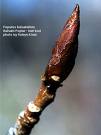Balsam Poplar Tree Information
Images of Balsam Poplar:






Balsam Poplar grows in the following 40 states and provinces:
Alaska, Alberta, British Columbia, Colorado, Connecticut, Delaware, Idaho, Illinois, Indiana, Iowa, Maine, Manitoba, Maryland, Massachusetts, Michigan, Minnesota, Montana, Nebraska, New Hampshire, New Jersey, New York, North Dakota, Northwest Territories, Nova Scotia, Ohio, Ontario, Oregon, Pennsylvania, Prince Edward Island, Rhode Island, Saskatchewan, South Dakota, Tennessee, Utah, Vermont, Virginia, West Virginia, Wisconsin, Wyoming, YukonInformation about Balsam Poplar:
as well ashe Populus Balsamifera is commonly known as the Balsam Poplar.
The scientific name of balsam poplar is Populus balsamifera L. subsp. balsamifera. Black cottonwood (Populus balsamifera subsp. trichocarpa) is the other subspecies of Populus balsamifera . For information on black cottonwood, see that FEIS review. Balsam poplar hybridizes with black cottonwood in Alaska, where ranges of the two trees overlap . It also hybridizes with narrowleaf cottonwood (P. angustifolia) , eastern cottonwood (P. deltoides) , and rarely with aspen (P. tremuloides) . LIFE FORM : Tree FEDERAL LEGAL STATUS : No special status OTHER STATUS : The South Dakota Natural Heritage Program lists balsam poplar as uncommon in the state .Balsam poplar occurs mainly in riparian areas of boreal and montane conifer forests . Its distribution extends from Alaska across most of Canada to Labrador and Newfoundland . In British Columbia it is restricted to areas east of the Rocky Mountains . Balsam poplar is rare in the northwestern United States, with sketchy records of its existence in Idaho and Oregon . It occurs sparingly in the Rocky Mountains of Montana, Wyoming, Utah, and Colorado and extends east through the northern Great Plains to the Atlantic Coast. It is found along creekbanks, moist hillsides, sandhill potholes, and knolls in North and South Dakota . North and east of the Great Plains, balsam poplar forms extensive floodplain forests . New York and West Virginia are alternately reported as the southern extreme for this tree in the eastern United States.Balsam poplar is a seral species that occurs primarily in ecotones between boreal forest and tundra or prairie, and along streams and rivers. It is most common in white spruce (Picea glauca) forests of Canada but can extend beyond the conifer treeline in western Canada and Alaska . Classifications including balsam poplar as a dominant component in community types (cts), plant associations (pas), or ecosystem associations (eas) are listed below. Area Classification Authority Alaska general veg. pas Viereck 1989 general veg. cts Viereck and Dyrness 1980 postfire forest cts Foote 1983 British Columbia general veg. eas Pojar & others 1984 Alberta general veg. cts Dirschl & others 1974 wc Alberta forest cts Corns 1983 Ontario forst eas Jones & others 1983 Canada general veg. pas Roi 1967 boreal forestsSome of the information provided here is attributed to:Harris, Holly T. 1990. Populus balsamifera subsp. balsamifera. In: Fire Effects Information System, [Online]. U.S. Department of Agriculture, Forest Service, Rocky Mountain Research Station, Fire Sciences Laboratory (Producer). , available at the USDA Fire Effects Information System (FEIS) website